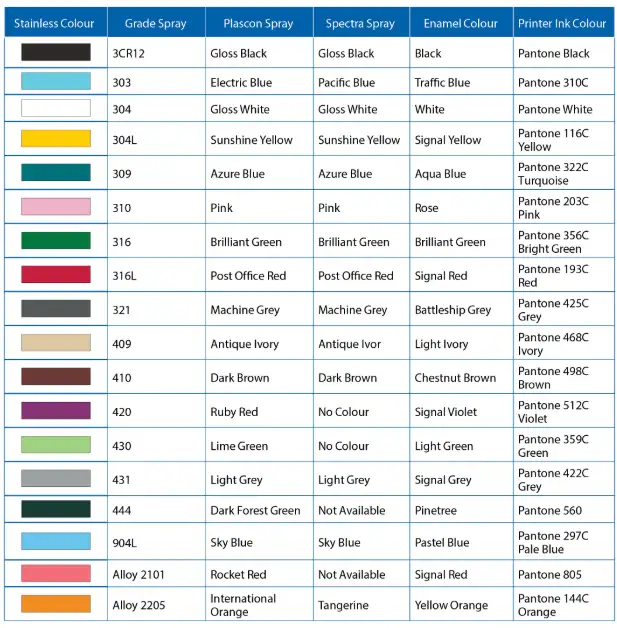Color codes provide an efficient, low-cost method for identifying stainless-steel grades at the mill, in inventory and on shipped bundles; when used together with mill stamps, heat-lot tags and paperwork they enable traceability, reduce mistakes, and speed production decisions. For buyers who require correct grade selection (for corrosion resistance, weldability and heat-treatment behavior), relying on color codes alone is not sufficient — but paired with certificates of conformity and simple checks they are a reliable first-pass identification tool. MWalloys supplies stainless materials with clear color marking, full traceability and 100% factory pricing with fast delivery from stock.
What “stainless steel color code” means
“Color code” in stainless distribution is a convention: a painted stripe, corner mark, or tag color applied to bars, sheets, plates and coils to indicate grade family or a specific alloy. The color mark is an immediate visual shorthand used by mills, service centers and fabricators to reduce picking errors. Color coding is not a metallurgical test — it’s a labeling convention — but when used correctly and recorded in paperwork it becomes a practical part of traceability and stock control.
Why mills and distributors color-code materials
Benefits:
-
Rapid identification on the shop floor for pickers and machine operators.
-
Faster inventory sorting at receiving and before shipping.
-
Simple visual checks for incompatible grade selection (for example, avoiding ferritic material in a job needing an austenitic 316).
-
When combined with marked mill certificates (MTCs) it supports traceability.
Limits:
-
Paint/stripe colors vary by mill and region; a color used by one supplier may mean a different grade at another.
-
Surface discoloration (weld heat tint, oil, lacquer) can obscure marks.
-
Color marks can wear off in handling; never rely on color alone for final acceptance.
How color codes are applied
Typical methods:
-
Corner dot or painted corner on sheet/plate bundles.
-
Edge stripe on coils and rounds.
-
Band or painted tag tied to bundles.
-
Thickness/grade stripe system: some mills paint the grade at a corner and thickness in the center in a different stripe system. (See supplier PDFs for practical examples.)
Practical notes:
-
Paint is chosen for adhesion, visibility and resistance to handling; many mills use industrial enamel or high-visibility tape.
-
Some service centers add secondary markings (heat number, PO) next to the color mark for dual verification.

Common color assignments — consolidated practical chart
Below is a consolidated, practical chart synthesised from mill color charts used by major suppliers. It merges typical assignments used by several distributors (representative examples only). Always confirm with the supplying mill or the bundle paperwork before final acceptance.
| Grade / Family | Typical color mark (examples from multiple mills) | Common uses / notes |
|---|---|---|
| 304 / 304L (austenitic) | Blue / Red-Blue variants | Most common general purpose grade for kitchens, tanks. |
| 316 / 316L (austenitic molybdenum) | Yellow / Pink / Yellow variants | Marine & chemical service; often given a distinct yellow tag. |
| 201 / 430 / ferritic | Green / Brown (varies) | 430 often dark green/black; 201 sometimes greenish. |
| 303 (free-machining) | Red or Pink | Machining grade; often red or pink on charts. |
| 410 / 420 (martensitic) | Black or Black with stripe | Heat-treatable stainless — common marking: black. |
| Duplex (2205) | Specific duplex color — e.g., purple or combined combo | Duplex alloys sometimes get a unique color or combination. |
| 17-4PH, 15-5PH (precipitation hardening) | Gold / Brown / Silver combos | Heat-treat variants frequently have two-color codes for temper. |
| Nickel alloys & superalloys (Inconel, Monel) | Distinct color codes (e.g., green/white, purple) | Usually separate from stainless family markings. |
Source charts used to compile the above: Penn Stainless color code table, Special Metals and Alro color PDFs and industry association guidance.
International and supplier variations — there is no single global “standard”
Important reality: there is no universally enforced global color standard for stainless steel grades. Regional mills and service centers define their own schemes and periodically update them. For example, suppliers in North America will publish color-code PDFs (corner codes + thickness marks) that can differ from charts used in Europe or South Africa. This is why buyers must confirm the meaning of colors with the supplying mill on every order. Practical rule: color = quick visual clue; certificate = authority.
Color vs stamping vs certificates
Best practice chain for acceptance:
-
Check the color mark against the supplier’s color chart (supplier PDF or web page).
-
Match the visible mill stamp/heat number to the MTC (mill test certificate).
-
Verify the certificate’s chemical and mechanical results (chromium, nickel, carbon, tensile) match the specified grade (ASTM/EN/ASME spec).
-
If any doubt, perform a quick positive material identification (PMI) or spectro test (portable XRF) before critical processing. Portable PMI is common when welds or corrosion resistance are mission critical.
Welding and heat discoloration: color does not equal metallurgy
Surface colors near welds — gold, blue, purple, brown, black — indicate oxide layers created by heat and oxygen exposure. These tints correlate to temperature exposure, not alloy composition, and they will change corrosion resistance in the heat-affected zone if not properly removed and passivated. Therefore:
-
Don’t confuse heat tint with grade identification paint.
-
After welding, remove heat tint via pickling, mechanical cleaning (brushing with stainless brush) and passivation when corrosion resistance is required.
Implementing color coding in your warehouse and shop
Warehouse checklist:
-
Keep the mill color chart at receiving and on the ERP item master.
-
Record heat numbers and attach the mill certificate to the PO and delivery note.
-
Use barcode or RFID tags tied to the heat number for double verification.
-
Repaint or remark bundles if the original marking is lost — but also update paperwork to show re-marking and the reason.
-
Train staff to never accept a grade by paint only; require MTC or PMI for critical components.
Operational tip: designate a “color map” poster near storage areas showing the supplier’s color assignments for quick cross-checks. (This reduces incorrect picks for common grades like 304/316/430.)
What to ask your supplier — MWalloys procurement checklist
When placing an order include:
-
Exact alloy designation (e.g., ASTM A240 Type 316L / EN 1.4404) and required mill spec.
-
Request the mill test certificate (MTC) per EN 10204 3.1 or 3.2 if needed.
-
Ask the supplier to confirm the color coding used on bundles and include a copy of their color chart with delivery.
-
If surface finish or passivation is required, specify method (pickling/neutralizing or passivation per ASTM A967 / ISO 8501 guidance).
-
For critical parts request PMI inspection on site or a certified lab analysis.
MWalloys policy: all stock shipped includes a color mark on bundles, the signed MTC, and a factory price quotation — we maintain fast stock turn for standard grades and provide verified traceability for each heat.
FAQs
-
Is there a worldwide standard color code for stainless steel?
No single global standard; most mills and distributors publish their own charts. Always confirm with the supplying mill. -
Can color marks be used as the legal proof of grade?
No, the mill test certificate (MTC) is the authoritative document. Color marks are a practical visual aid only. -
What color usually means 316?
Many suppliers use yellow or a yellow variant for 316/316L, but this is not universal — check the supplier’s chart. -
How do you treat weld heat tint?
Remove by pickling or mechanical cleaning then passivate per ASTM A967 or equivalent local standard to restore corrosion resistance. -
Will color coding help with traceability?
Yes, when combined with stamped heat numbers and MTCs it strengthens traceability; color alone is insufficient. -
Are color codes used for thickness identification?
Some mills combine grade color with separate thickness marks; check the specific supplier legend. -
What if a bundle has the wrong color but correct certificate?
Reconcile heat number and certificate; retag the bundle and log the discrepancy — don’t assume the paint alone is authority. -
Can I rely on XRF/PMI instead of color?
PMI/XRF provides an alloy snapshot and is useful for quick verification. For full mechanical property confirmation, use the MTC or lab testing. -
Which international specs should I reference for passivation?
ASTM A967 covers procedures for chemical passivation of stainless steel; consult local EN/ISO equivalents where required. -
How does MWalloys help with color code uncertainties?
MWalloys ships bundles with consistent color marking, includes the MTC, and offers PMI or lab testing on request. Our stock program and factory pricing shorten procurement cycles for standard grades.
Practical annex — consolidated grade color table
| Grade | Typical color (example) | Typical use |
|---|---|---|
| 201 | Greenish | Low cost decorative and non-critical components |
| 304 / 304L | Blue variants | Food service, equipment, general fabrication |
| 316 / 316L | Yellow / Pink | Marine, chemical, chloride environments |
| 303 | Red / Pink | Free-machining bar and rod |
| 410 / 420 | Black | Cutlery, bearings, hardened parts |
| Duplex 2205 | Purple / Combined | Higher strength, corrosion resistance in chloride media |
| 17-4PH | Gold / Brown | Heat-treatable structural components |
Sources: consolidated mill color charts from PennStainless, Special Metals and Alro.

